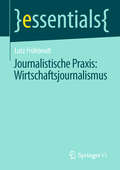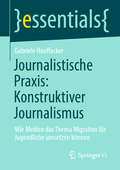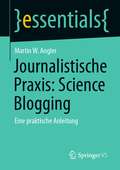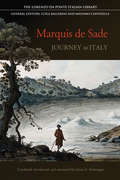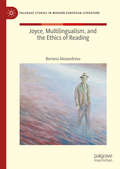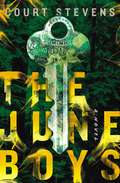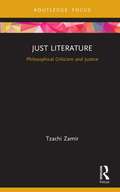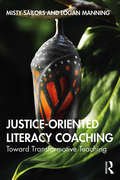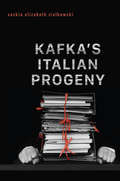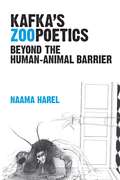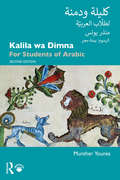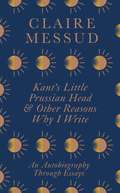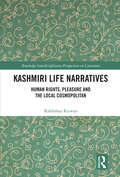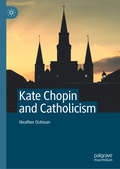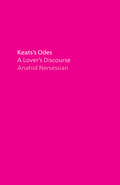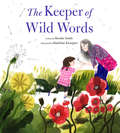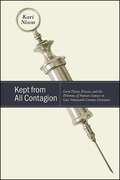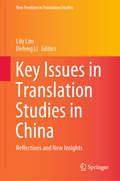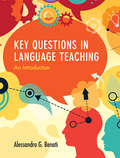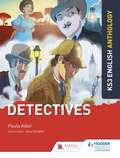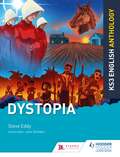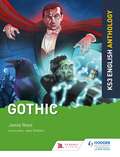- Table View
- List View
Journalistische Praxis: Ein Handbuch Für Ausbildung Und Praxis (essentials)
by Lutz FrühbrodtErzählen, erklären, einordnen: Lutz Frühbrodt zeigt, wie moderner Wirtschaftsjournalismus funktioniert. Der Band startet mit den jüngeren Umwälzungen innerhalb des Ressorts, dekliniert die typischen Anlässe und Textformate durch und endet mit einem Plädoyer für eine „Nachhaltigkeits-Perspektive“ in der Unternehmensberichterstattung.
Journalistische Praxis: Wie Medien das Thema Migration für Jugendliche umsetzen können (essentials)
by Gabriele HooffackerHeranwachsende wünschen sich Medien, die verständlich berichten, Hintergründe und Lösungsmöglichkeiten aufzeigen. Wie das Konzept des konstruktiven Journalismus dabei hilft und wie es in der Journalismusausbildung eingesetzt werden kann, zeigt dieses Buch.
Journalistische Praxis: Eine praktische Anleitung (essentials)
by Martin W. AnglerKein Medium kann Wissenschaft so schnell der Öffentlichkeit vermitteln wie das Web. Blogs spielen dabei eine maßgebliche Rolle, weil sie in puncto Substanz genau zwischen hochkomplexen Papers und sehr vereinfachten Social Media-Beiträgen liegen. Dieses Buch zeigt, wieso Wissenschaftler diese Art des Publizierens in ihre Forschungsarbeit integrieren sollten. Es gibt praktische Ratschläge darüber, wie Blogs geplant werden müssen, wie sich Blogposts strukturieren lassen, welche geschriebenen Formate am effektivsten zur Wissenschaftskommunikation funktionieren und wie die Beiträge so geplant und publiziert werden können, dass sie ihr Publikum erreichen.
Journey to Italy (Lorenzo Da Ponte Italian Library)
by Marquis de SadeIn 1775, the young Count de Sade decided to turn a flight from legal trouble into an opportunity to undertake the "grand tour." He transformed his sojourns in Florence, Rome, Naples, and their environs into a philosophical travelogue; alongside advice on where to go and what to see, his Journey to Italy would include analyses of local customs and institutions, history and politics, natural phenomena, and the development of the arts. For today’s readers, Journey to Italy provides remarkable portraits of major Italian cities and the surrounding countryside, vivid accounts of aristocratic and popular entertainments, and a clear sense of what it was like to be a tourist in eighteenth-century Italy – from scams, rough roads, and unreliable guidebooks to learned interlocutors, balls, and nights at the opera. We witness Sade learning about the lives of Roman emperors, the machinations and misdeeds of pontiffs, the power struggles of the Medici, the ancient libertine world revealed by the excavations of Herculaneum and Pompeii, and a host of artistic examples and cultural practices – the material he would soon metamorphose into trenchant satire, gothic horror, and violent sexual fantasy. This book presents the first English translation of Sade’s unfinished and unpolished Journey to Italy along with his extensive dossiers of notations, sketches, plans, and correspondence. The translation is accompanied by extensive explanatory annotations and preceded by a critical introduction that provides biographical, artistic, historical, and intellectual context for Sade’s fascinating project, connecting his travels in and writings about Italy to his later famous and controversial works.
Joyce, Multilingualism, and the Ethics of Reading: Deplurabel Muttertongues (Palgrave Studies in Modern European Literature)
by Boriana AlexandrovaWhat if our notions of the nation as a site of belonging, the home as a safe place, or the mother tongue as a means to fluent comprehension did not apply? What if fluency were a hindrance, whilst our differences and contradictions held the keys to radical new ways of knowing? Taking inspiration from the practice of language learning and translation, this book explores the extraordinary creative possibilities, politics, and ethics of adopting a multilingual approach to reading. Its case study, James Joyce’s Finnegans Wake (1939), is a text in equal measures exhilarating and exasperating: an unhinged portrait of European modernist debates on transculturalism and globalisation, here considered on the backdrop of current discourses on migration, race, gender, and neurodiversity. This book offers a fresh perspective on the illuminating, if perplexing, work of a beloved European modernist, whilst posing questions far beyond Joyce: on negotiating difference in an increasingly globalised world; on braving the difficulty of relating across languages and cultures; and ultimately on imagining possible futures where multilingual literature can empower us to read, relate, and conceptualise differently.
The June Boys
by Court StevensThe Gemini Thief could be anyone.Your father, your mother, your best friend&’s crazy uncle.Some country music star&’s deranged sister. Anyone.Someone is stealing Tennessee&’s boys.REPORT SUSPICIOUS BEHAVIOR.The Gemini Thief is a serial kidnapper, who takes three boys and holds them captive from June 1st to June 30th of the following year. The June Boys endure thirteen months of being stolen, hidden, observed, and fed before they are released, unharmed, by their masked captor. The Thief is a pro, having eluded authorities for nearly a decade and taken at least twelve boys.Now Thea Delacroix has reason to believe the Gemini Thief has taken a thirteenth victim: her cousin, Aulus McClaghen.But the game changes when one of the kidnapped boys turns up dead. Together with her boyfriend Nick and her best friends, Thea is determined to find the Gemini Thief and the remaining boys before it&’s too late. Only she&’s beginning to wonder something sinister, something repulsive, something unbelievable, and yet, not impossible:What if her father is the Gemini Thief?Praise for The June Boys:&“Not only a terrifying story of the missing, but a heartbreaking, hopeful journey through the darkness.&” —MEGAN MIRANDA, New York Times bestselling author of The Last House Guest&“Stunning twists and turns. Hang on tight.&” —RUTA SEPETYS, international bestselling author&“A gripping suspense that hooked me from the first sentence.&” —COLLEEN COBLE, USA TODAY bestselling author of One Little Lie and the Lavender Tides series&“I was hooked and couldn&’t stop reading.&” —CATHERINE BOCK, book buyer for Parnassus BooksFull-length, stand-alone Young Adult suspense novelIncludes Discussion Questions for Book Clubs
Just Literature: Philosophical Criticism and Justice (New Literary Theory)
by Tzachi ZamirIn Just Literature, Tzachi Zamir introduces the idea of 'philosophical criticism' as an innovative approach to interpreting literary texts. Throughout the book, Zamir uses the theme of justice as a case study for this new critical approach. By using ‘philosophical criticism’, Zamir posits that a stronger grasp of the idea of justice can increase one’s understanding of literature, and thus its value. He offers philosophical readings of works by Dante, Shakespeare, Toni Morrison, J. M. Coetzee and Philip Roth to explore the relationship between aesthetic and epistemic value. Zamir argues that, while literature and philosophy remain separate entities, examining the two in tandem may help inform the study of both. Offering an inventive twist on an established dynamic, this book is essential reading for any student or scholar of literature or philosophy.
Justice-oriented Literacy Coaching: Toward Transformative Teaching
by Misty Sailors Logan ManningThis book explores notions of justice-oriented literacy coaching and offers a way of being in the world with young people, teachers, and communities that centers transformative coaching, teaching, and learning. It is intended to disrupt the traditional and historical positioning of literacy coaches in schools today. Through the lens of social justice and liberatory education, Sailors and Manning begin a dialogue with literacy coaches to help them reconsider their own roles and positions as agents of change in schools. Using vignettes and stories to illustrate potential paths into emancipatory literacy learning environments, the authors present literacy as a socially-situated act of meaning-making. Accessible and inviting, this book provides pragmatic tools for literacy leaders to embody social justice, to grapple with big social concepts, to imagine possibilities, and to stimulate creative thinking with the teachers at their schools and with the students in their classrooms. Intended for literacy coaches in grades K-6 and graduate students in literacy education, this book includes a wealth of resources and examples from real-world contexts, as well as spaces for the reader to interact and engage with the text through journaling and self-reflection.
Kafka’s Italian Progeny (Toronto Italian Studies)
by Saskia Elizabeth ZiolkowskiWhile many scholars of world literature view national literary traditions as resolved and stable, Kafka’s Italian Progeny takes the fluid identity of the modern Italian tradition as an opportunity to reconsider its dimensions and influencers. Exploring a distinct but unexamined Kafkan tradition in modern Italian literature, it brings Italian literary works into larger debates and reorients the critical view of the Italian literary landscape. The book calls attention to the way Kafkan themes, narrative strategies, and formal experimentation appear in a range of Italian authors. Offering new perspectives on familiar figures, such as Italo Calvino, Italo Svevo, and Elena Ferrante, it also sheds light on some lesser-known authors, including Tommaso Landolfi, Paola Capriolo, and Lalla Romano. Using diverse approaches to explore thematic, generic, historical, and cultural connections between Kafka’s works and those of Italian authors, the author argues for a new view of Italian literature that includes talking animals, parental bonds, modernist realism, literary detective novels, and lyrical microfiction. Whereas Kafka has been mobilized in discourses on minor and world literature, Kafka’s Italian Progeny investigates the particular nature of the Italian reception of Kafka to reveal the richness and variety of modern Italian literature.
Kafka's Zoopoetics: Beyond the Human-Animal Barrier
by Naama HarelNonhuman figures are ubiquitous in the work of Franz Kafka, from his early stories down to his very last one. Despite their prominence throughout his oeuvre, Kafka’s animal representations have been considered first and foremost as mere allegories of intrahuman matters. In recent years, the allegorization of Kafka’s animals has been poetically dismissed by Kafka’s commentators and politically rejected by posthumanist scholars. Such critique, however, has yet to inspire either an overarching or an interdiscursive account. This book aims to fill this lacuna. Positing animal stories as a distinct and significant corpus within Kafka’s entire poetics, and closely examining them in dialogue with both literary and posthumanist analysis, Kafka’s Zoopoetics critically revisits animality, interspecies relations, and the very human-animal contradistinction in the writings of Franz Kafka. Kafka’s animals typically stand at the threshold between humanity and animality, fusing together human and nonhuman features. Among his liminal creatures we find a human transformed into vermin (in “The Metamorphosis”), an ape turned into a human being (in “A Report to an Academy”), talking jackals (in “Jackals and Arabs”), a philosophical dog (in “Researches of a Dog”), a contemplative mole-like creature (in “The Burrow”), and indiscernible beings (in “Josefine, the Singer or the Mouse People”). Depicting species boundaries as mutable and obscure, Kafka creates a fluid human-animal space, which can be described as “humanimal.” The constitution of a humanimal space radically undermines the stark barrier between human and other animals, dictated by the anthropocentric paradigm. Through denying animalistic elements in humans, and disavowing the agency of nonhuman animals, excluding them from social life, and neutralizing compassion for them, this barrier has been designed to regularize both humanity and animality. The contextualization of Kafka's animals within posthumanist theory engenders a post-anthropocentric arena, which is simultaneously both imagined and very real.
Kalila wa Dimna: For Students of Arabic
by Munther YounesSpecifically designed for students of Arabic, this fully illustrated rendition of the Arabic literary classic enhances students’ reading, listening, speaking, and writing skills through the medium of these fun, engaging, and culturally relevant tales. The first part of this second edition follows the original order of the stories, with new vocabulary explained in footnotes throughout. In the second part, grammar explanations and a wealth of exercises provide ample opportunities for readers to improve their understanding of the stories and strengthen their command of Arabic grammar and Arabic writing. The audio material, containing the texts of the stories read by native speakers, is available to download free online to help develop the learner’s listening skills. Suitable for both class use and independent study, Kalila wa Dimna: for Students of Arabic is a must for all intermediate to advanced students wishing to enhance their language skills and discover one of the most popular pieces of Arabic literature ever written.
Kant's Little Prussian Head and Other Reasons Why I Write: An Autobiography Through Essays
by Claire Messud'An uplifting work: complex, precise and bracing' Susie Boyt, Financial Times'A profound book about the intrication of literature and life, about the modest, miraculous ways art helps us to live' Garth GreenwellIn twenty-nine intimate, brilliant and funny essays, Claire Messud reflects on a childhood move from her Connecticut home to Australia; the complex relationship between her modern Canadian mother and a fiercely single French Catholic aunt; and a trip to Beirut, where her pied-noir father had once lived, while he was dying. She meditates on contemporary classics from Kazuo Ishiguro, Teju Cole, Rachel Cusk and Valeria Luiselli; examines three facets of Albert Camus and The Stranger; and tours her favorite paintings at Boston's Museum of Fine Arts. Crafting a vivid portrait of a life in celebration of the power of literature, Messud proves once again 'an absolute master storyteller' (Rebecca Carroll, Los Angeles Times).'I can think of few writers capable of such thrilling seriousness expressed with so lavish a gift' Rachel Cusk, Evening Standard
Kashmiri Life Narratives: Human Rights, Pleasure and the Local Cosmopolitan (Routledge Interdisciplinary Perspectives on Literature)
by Rakhshan RizwanKashmiri Life Narratives takes as its central focus writings -- memoirs, non-fictional and fictional Bildungsromane -- published circa 2008 by Kashmiris/Indians living in the Valley of Kashmir, India or in the diaspora. It offers a new perspective on these works by analyzing them within the framework of human rights discourse and advocacy. Literature has been an important medium for promoting the rights of marginalized Kashmiri subjects within Indian-occupied Kashmir and that it has been successful in putting Kashmir back on the global map and in shifting discussion about Kashmir from the political board rooms to the international English-language book market. In discussing human rights advocacy through literature, this book also effects a radical change of perspective by highlighting positive rights (to enjoy certain things) rather than negative ones (to be spared certain things). Kashmiri life narratives deploy a language of pleasure rather than of physical pain to represent the state of having and losing rights.
Kate Chopin and Catholicism
by Heather OstmanThis book explores the Catholic aesthetic and mystical dimensions in KateChopin’s fiction within the context of an evolving American Catholicism in thelate nineteenth and early twentieth centuries. Through a close reading of hernovels and numerous short stories, Kate Chopin and Catholicism looks at theways Chopin represented Catholicism in her work as a literary device that servedon multiple levels: as an aesthetic within local color depictions of Louisiana, as atrope for illuminating the tensions surrounding nineteenth-century women’sstruggles for autonomy, as a critique of the Catholic dogma that subordinatedauthenticity and physical and emotional pleasure, and as it pointed to thedistinction between religious doctrine and mystical experience, and enabled thearticulation of spirituality beyond the context of the Church. This book revealsChopin to be not only a literary visionary but a writer who saw divinity in thenatural world.
Keats's Odes: A Lover's Discourse
by Anahid Nersessian“When I say this book is a love story, I mean it is about things that cannot be gotten over—like this world, and some of the people in it.” In 1819, the poet John Keats wrote six poems that would become known as the Great Odes. Some of them—“Ode to a Nightingale,” “To Autumn”—are among the most celebrated poems in the English language. Anahid Nersessian here collects and elucidates each of the odes and offers a meditative, personal essay in response to each, revealing why these poems still have so much to say to us, especially in a time of ongoing political crisis. Her Keats is an unflinching antagonist of modern life—of capitalism, of the British Empire, of the destruction of the planet—as well as a passionate idealist for whom every poem is a love poem. The book emerges from Nersessian’s lifelong attachment to Keats’s poetry; but more, it “is a love story: between me and Keats, and not just Keats.” Drawing on experiences from her own life, Nersessian celebrates Keats even as she grieves him and counts her own losses—and Nersessian, like Keats, has a passionate awareness of the reality of human suffering, but also a willingness to explore the possibility that the world, at least, could still be saved. Intimate and speculative, this brilliant mix of the poetic and the personal will find its home among the numerous fans of Keats’s enduring work.
The Keeper of Wild Words: (nature For Kids, Exploring Nature With Children)
by Brooke SmithA touching tale of a grandmother and her granddaughter exploring and cherishing the natural world.Words, the woods, and the world illuminate this quest to save the most important pieces of our language—by saving the very things they stand for.When Mimi finds out her favorite words—simple words, like apricot, blackberry, buttercup—are disappearing from the English language, she elects her granddaughter Brook as their Keeper. And did you know? The only way to save words is to know them.• With its focus on the power of language and social change, The Keeper of Wild Words is ideal for educators and librarians as well as young readers.• For any child who longs to get outside and learn more about nature and the environment• A loving portrait of the special relationship that grandparents have with their grandchildrenFor children who love such books as Outside Your Window: A First Book of Nature, And Then It's Spring, and Finding Wild.Brooke Smith is a poet and children's book author. She lives in Bend, Oregon, at the end of a long cinder lane. Brooke writes daily from her studio, looking at the meadow and many of the wild words she cherishes.Madeline Kloepper is a Canadian artist with a Bachelor of Fine Arts and Major in Illustration from Emily Carr University of Art and Design. Her work is influenced by childhood, nostalgia, and the relationships we forge with nature. She lives in Prince George, British Columbia.
Kept from All Contagion: Germ Theory, Disease, and the Dilemma of Human Contact in Late Nineteenth-Century Literature (SUNY series, Studies in the Long Nineteenth Century)
by Kari NixonKept from All Contagion explores the surprising social effects of germ theory in the late nineteenth century. Connecting groups of authors rarely studied in tandem by highlighting their shared interest in changing interpersonal relationships in the wake of germ theory, this book takes a surprising and refreshing stance on studies in medicine and literature.Each chapter focuses on a different disease, discussing the different social policies or dilemmas that arose from new understandings in the 1860s–1890s that these diseases were contagious. The chapters pair these sociohistorical considerations with robust literary analyses that assess the ways authors as diverse as Thomas Hardy, Henrik Ibsen, and Mary Elizabeth Braddon, among others, grappled with these ideas and their various impacts upon different human relationships—marital, filial, and social.Through the trifocal structure of each chapter (microbial, relational, and sociopolitical), the book excavates previously overlooked connections between literary texts that insist upon the life-giving importance of community engagement—the very thing that seemed threatening in the wake of germ theory's revelations. Germ theory seemed to promote self-protection via isolation; the authors covered in Kept from All Contagion resist such tacit biopolitical implications. Instead, as Kari Nixon shows, they repeatedly demonstrate vitalizing interpersonal interactions in spite of—and often because of—their contamination with disease, thus completely upending both the ways Victorians and present-day literary scholars have tended to portray and interpret purity.
Key Issues in Translation Studies in China: Reflections and New Insights (New Frontiers in Translation Studies)
by Lily Lim Defeng LiThis book revisits a number of key issues in Chinese Translation Studies. Reflecting on e.g. what Translation Studies researchers have achieved in the past, and the extent to which the central issues have been addressed and what still needs to be done, a group of respected scholars share their expertise in order to identify some tangible directions and potential areas for future research. In addition, the book discusses a number of key themes, e.g. Translation Studies as a discipline and its essential characteristics, the cultural dimension in translator training, paradigms of curriculum design, the reform of assessment for professional qualification, acts and translation shifts, the principle of faithfulness in translation, and interpreter’s cognitive processing routes. The book offers a useful reference guide for a broad readership including graduate students, and shares insiders’ accounts of various current topics and issues in Chinese Translation Studies. Given its scope, it is also a valuable resource for researchers interested in translation studies in the Chinese context.
Key Questions in Language Teaching: An Introduction
by Alessandro G. BenatiInnovative and evidence-based, this introduction to the main concepts and issues in language teaching uses a 'key questions' structure, enabling the reader to understand how these questions have been addressed by researchers previously, and how the findings inform language teaching practices. Grounded in research, theory and empirical evidence, the textbook provides students, practitioners and teachers with a complete introductory course in language teaching. Written in a clear and user-friendly style, and avoiding use of jargon, the book draws upon real-life teaching experiences and scenarios to provide practical advice. A glossary of key terms, questions for discussion and further reading suggestions are included. The book is perfectly suited to language teaching modules on English language, TESOL and applied linguistics courses.
Key Stage 3 English Anthology: Detectives
by Paula AdairInspire your teaching with Key Stage 3 English Anthology: Detectives, a themed anthology for Year 7. Featuring mysterious page turners starring Sherlock Holmes and Poirot, this Anthology guides students through fiction, non-fiction and poetry, encouraging them to connect with a variety of texts to gain a thorough understanding of the context and literary techniques underpinning each piece.Each extract is supported by Teaching and Learning Resources, including quizzes, lesson plans and PowerPoint slides to help you implement the content of the book.Each extract includes:- A context panel to provide key information to set the scene - Glossaries and annotations to help students work through each extract confidently- Look closer: key questions for students to consider as they work through the extracts- Now try this: writing and speaking activities to encourage students to get creative and actively engage with the text- Fast finisher tasks to support students who race ahead- A practice question to familiarise students with the command words they will see at GCSE
Key Stage 3 English Anthology: Detectives
by Paula Adair Jane SheldonInspire your teaching with Key Stage 3 English Anthology: Detectives, a themed anthology for Year 7. Featuring mysterious page turners starring Sherlock Holmes and Poirot, this Anthology guides students through fiction, non-fiction and poetry, encouraging them to connect with a variety of texts to gain a thorough understanding of the context and literary techniques underpinning each piece.Each extract is supported by Teaching and Learning Resources, including quizzes, lesson plans and PowerPoint slides to help you implement the content of the book.Each extract includes:- A context panel to provide key information to set the scene - Glossaries and annotations to help students work through each extract confidently- Look closer: key questions for students to consider as they work through the extracts- Now try this: writing and speaking activities to encourage students to get creative and actively engage with the text- Fast finisher tasks to support students who race ahead- A practice question to familiarise students with the command words they will see at GCSE
Key Stage 3 English Anthology: Dystopia
by Steve EddyInspire your teaching with Key Stage 3 English Anthology: Dystopia, a themed anthology for Year 9. Featuring Animal Farm, The Handmaid's Tale and Lord of the Flies, this Anthology guides students through fiction, non-fiction and poetry, encouraging them to connect with a variety of texts to gain a thorough understanding of the context and literary techniques underpinning each piece of work.Each extract is supported by Teaching and Learning Resources, including quizzes, lesson plans and PowerPoint slides to help you implement the content of the book.Each extract includes:- A context panel to provide key information to set the scene- Glossaries and annotations to help students work through each extract confidently- Look closer: key questions for students to consider as they work through the extracts- Now try this: writing and speaking activities to encourage students to get creative and actively engage with the text- Fast finisher tasks to support students who race ahead- A practice question to familiarise students with the command words they will see at GCSE
Key Stage 3 English Anthology: Dystopia
by Steve Eddy Jane SheldonInspire your teaching with Key Stage 3 English Anthology: Dystopia, a themed anthology for Year 9. Featuring Animal Farm, The Handmaid's Tale and Lord of the Flies, this Anthology guides students through fiction, non-fiction and poetry, encouraging them to connect with a variety of texts to gain a thorough understanding of the context and literary techniques underpinning each piece of work.Each extract is supported by Teaching and Learning Resources, including quizzes, lesson plans and PowerPoint slides to help you implement the content of the book.Each extract includes:- A context panel to provide key information to set the scene- Glossaries and annotations to help students work through each extract confidently- Look closer: key questions for students to consider as they work through the extracts- Now try this: writing and speaking activities to encourage students to get creative and actively engage with the text- Fast finisher tasks to support students who race ahead- A practice question to familiarise students with the command words they will see at GCSE
Key Stage 3 English Anthology: Gothic
by Jamie ReesInspire your teaching with Key Stage 3 English Anthology: Gothic, a themed anthology for Year 8.Featuring texts full of suspense, horror and gloom such as Frankenstein and Dracula, this anthology guides students through fiction, non-fiction and poetry encouraging them to connect with a variety of texts to gain a thorough understanding of the context and literary techniques underpinning each piece of work.Each extract is supported by Teaching and Learning Resources, including quizzes, lesson plans and PowerPoint slides to help you implement the content of the book.Each extract includes:- A context panel to provide key information to set the scene of each extract- Glossaries and annotations to help students work through each extract confidently- Look closer: key questions for students to consider as they work through the extracts- Now try this: writing and speaking activities to encourage students to get creative and actively engage with the text- Fast finisher tasks to support students who race ahead- A practice question to familiarise students with the command words they will see at GCSE
Key Stage 3 English Anthology: Gothic
by Jamie Rees Jane SheldonInspire your teaching with Key Stage 3 English Anthology: Gothic, a themed anthology for Year 8.Featuring texts full of suspense, horror and gloom such as Frankenstein and Dracula, this anthology guides students through fiction, non-fiction and poetry encouraging them to connect with a variety of texts to gain a thorough understanding of the context and literary techniques underpinning each piece of work.Each extract is supported by Teaching and Learning Resources, including quizzes, lesson plans and PowerPoint slides to help you implement the content of the book.Each extract includes:- A context panel to provide key information to set the scene of each extract- Glossaries and annotations to help students work through each extract confidently- Look closer: key questions for students to consider as they work through the extracts- Now try this: writing and speaking activities to encourage students to get creative and actively engage with the text- Fast finisher tasks to support students who race ahead- A practice question to familiarise students with the command words they will see at GCSE
